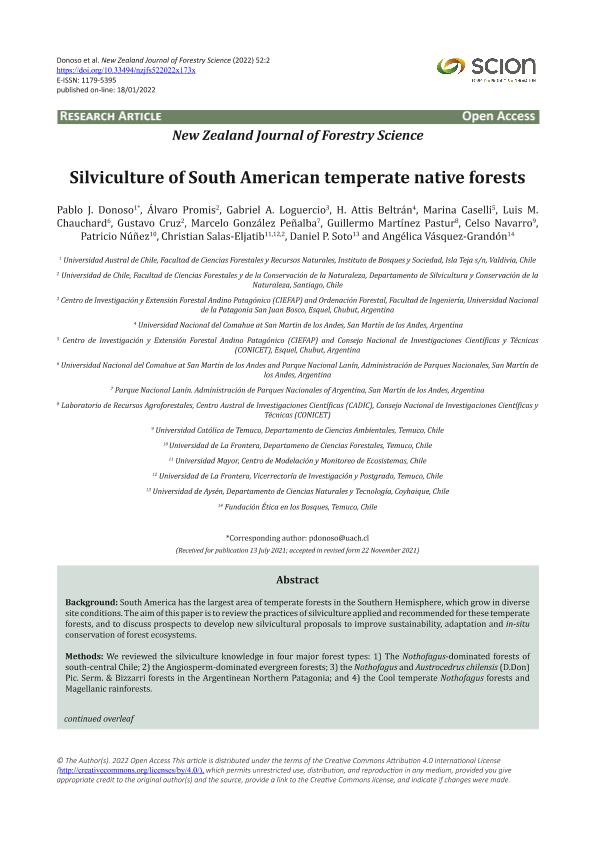Artículo
Silviculture of South American temperate native forests
Donoso, Pablo J.; Promis, Álvaro; Loguercio, Gabriel Angel ; Attis Beltrán, H.; Caselli, Marina
; Attis Beltrán, H.; Caselli, Marina ; Chauchards, Luis Mario; Cruz, Gustavo; González Peñalba, Marcelo; Martínez Pastur, Guillermo José
; Chauchards, Luis Mario; Cruz, Gustavo; González Peñalba, Marcelo; Martínez Pastur, Guillermo José ; Navarro, Jorge Celso; Núñez, Patricio; Salas Eljatib, Christian; Soto, Daniel P.; Vásquez Grandón, Angélica
; Navarro, Jorge Celso; Núñez, Patricio; Salas Eljatib, Christian; Soto, Daniel P.; Vásquez Grandón, Angélica
 ; Attis Beltrán, H.; Caselli, Marina
; Attis Beltrán, H.; Caselli, Marina ; Chauchards, Luis Mario; Cruz, Gustavo; González Peñalba, Marcelo; Martínez Pastur, Guillermo José
; Chauchards, Luis Mario; Cruz, Gustavo; González Peñalba, Marcelo; Martínez Pastur, Guillermo José ; Navarro, Jorge Celso; Núñez, Patricio; Salas Eljatib, Christian; Soto, Daniel P.; Vásquez Grandón, Angélica
; Navarro, Jorge Celso; Núñez, Patricio; Salas Eljatib, Christian; Soto, Daniel P.; Vásquez Grandón, Angélica
Fecha de publicación:
01/2022
Editorial:
New Zealand Forest Research Institute
Revista:
New Zealand Journal Of Forestry Science
ISSN:
0048-0134
e-ISSN:
1179-5395
Idioma:
Inglés
Tipo de recurso:
Artículo publicado
Clasificación temática:
Resumen
Background: South America has the largest area of temperate forests in the Southern Hemisphere, which grow in diverse site conditions. The aim of this paper is to review the practices of silviculture applied and recommended for these temperate forests, and to discuss prospects to develop new silvicultural proposals to improve sustainability, adaptation and in-situ conservation of forest ecosystems. Methods: We reviewed the silviculture knowledge in four major forest types: 1) The Nothofagus-dominated forests of south-central Chile; 2) the Angiosperm-dominated evergreen forests; 3) the Nothofagus and Austrocedrus chilensis (D.Don) Pic. Serm. & Bizzarri forests in the Argentinean Northern Patagonia; and 4) the Cool temperate Nothofagus forests and Magellanic rainforests. Results: In Chile, both Nothofagus-dominated and Angiosperm-dominated evergreen forests are diverse in tree species, and mixed-species silviculture with commercially valuable species of variable shade tolerance is most promising. Some secondary forests can reach growth rates as high as 20 m3ha-1yr-1. After thinnings, stands with 35–60% of residual densities have shown the best responses in growth. Even-aged silvicultural methods have shown a rapid reorganization and development of new cohorts, although, where Chusquea species are conspicuous, regeneration establishment requires controlling competing vegetation. Preliminary results also show interesting prospects for single-tree selection cuts in uneven-aged forests. East of the Andes, in Argentina, mixed Nothofagus forests and pure and mixed Nothofagus and A. chilensis forests occur. The shelterwood method has been the most practised and successful in the mixed Nothofagus forests, with abundant regeneration, and good growth rates. For A. chilensis forests, an adaptive management approach is proposed, conditioned by the cypress disease attack (e.g., Phytophthora austrocedri). Conversion of pure A. chilensis to mixed A. chilensis–N. dombeyi forests could increase growth considerably. Finally, in the cool temperate Nothofagus forests and Magellanic rainforests, shared by Chile and Argentina, the regular shelterwood cuts have been the most common silvicultural method, with massive regeneration a decade after the regeneration felling. Since the two major Nothofagus species in these forests regenerate well in gaps, uneven-aged silviculture seems also promising. Conclusions: There is abundant knowledge about the silviculture of these forest types. However, there are opportunities for several silvicultural systems to better contribute to sustainable forest management, reverse forest degradation, and cope with climate change challenges, primarily through developing mixed and single-species productive and carbon-rich forests, with greater adaptive capacity.
Archivos asociados
Licencia
Identificadores
Colecciones
Articulos(SEDE CENTRAL)
Articulos de SEDE CENTRAL
Articulos de SEDE CENTRAL
Citación
Donoso, Pablo J.; Promis, Álvaro; Loguercio, Gabriel Angel; Attis Beltrán, H.; Caselli, Marina; et al.; Silviculture of South American temperate native forests; New Zealand Forest Research Institute; New Zealand Journal Of Forestry Science; 52; 1-2022; 1-32
Compartir
Altmétricas
Items relacionados
Mostrando titulos relacionados por título, autor y tema.
-
Carabelli, Francisco Andrés Carabelli ; Lupi, Ana María; Graciano, Corina ; Villagra, Pablo Eugenio (Universidad Nacional de Santiago del Estero. Facultad de Ciencias Forestales, 2019-12)
-
Carabelli, Francisco Andrés Carabelli ; Lupi, Ana María; Graziano, Corina; Villagra, Pablo Eugenio (Universidad Nacional de Santiago del Estero. Facultad de Ciencias Forestales, 2019-12)
-
Mansilla, Paula Romina ; Pancotto, Veronica Andrea ; Moretto, Alicia Susana ; Vrsalovic, Jazmin ; Escobar, Julio Martin ; Oro Castro, Natalia Patricia ; Lencinas, María Vanessa (Sociedad Argentina de Botánica, 2013-09)



